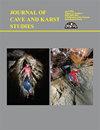在美国华盛顿圣海伦斯火山的火山口,一个新的冰川火山洞穴系统正在发生
IF 0.5
4区 地球科学
Q4 GEOSCIENCES, MULTIDISCIPLINARY
引用次数: 2
摘要
圣海伦斯火山是喀斯喀特火山弧中风险最高的火山之一,它拥有一个新的冰川火山洞穴系统,这些洞穴形成于2004 - 2008年的熔岩穹丘周围。从2014年到2021年,一个多学科研究团队系统地探索并绘制了这些新洞穴的地图,以确定它们的特征。同时还监测了空气和喷气孔温度、体积流速和风力状况。在火山口内形成了超过3.0 km的半圆形洞穴通道,为以下研究提供了机会:(1)观察洞穴随时间的发展,(2)确定低温熔岩孔是洞穴形成的主要动力,(3)验证季节性积雪对洞穴气候的影响,(4)评估新熔岩穹窿冰下和地面部分的热量分布。圣海伦火山的冰火洞穴系统相对较年轻(小于10年),是太平洋西北部最具活力的洞穴系统。在研究过程中观察到的洞穴膨胀表明,相互关联的系统正在发生和未来形成。然而,进一步的扩张也可能受到熔岩穹窿上部喷气孔温度升高、雪超载造成的洞穴不稳定或冰下火山热输出变化的限制。新的冰火溶洞系统的发育为冰川覆盖火山的火山活动提供了独特的晴雨表,并为研究冰下环境提供了有利条件。我们在这个动态洞穴系统中提出了八年的初步研究结果,并讨论了未来纵向分析的途径。本文章由计算机程序翻译,如有差异,请以英文原文为准。
Ongoing genesis of a novel glaciovolcanic cave system in the crater of Mount St. Helens, Washington, USA
Mount St. Helens, one of the highest-risk volcanoes in the Cascade Volcanic Arc, hosts a novel system of glaciovolcanic caves that has formed around the 2004−2008 lava dome. From 2014 to 2021 a multidisciplinary research team systematically explored and mapped these new caves to ascertain their characteristics. Air and fumarole temperatures, volume flow rates, and wind regimes were also monitored. More than 3.0 km of cave passages have formed in a semicircular pattern in the volcanic crater and provide an opportunity to (1) observe cave development over time, (2) identify low temperature fumaroles as the main driving force for cave formation, (3) verify the impact of seasonal snow accumulation on cave climate, and (4) assess heat distribution in subglacial and subaerial portions of the new lava dome. Glaciovolcanic cave systems on Mount St. Helens are comparatively young (<10 years) and the most dynamic in the Pacific Northwest. Observed cave expansion during the study suggests ongoing genesis and future formation of interconnected systems. However, further expansion may also be limited by increasing fumarole temperatures towards the upper parts of the lava dome, cave instability due to snow overload, or variable subglacial volcanic heat output. New glaciovolcanic cave system development provides a unique barometer of volcanic activity on glacier-mantled volcanoes and to study the subglacial environment. We present the results of eight years of initial study within this dynamic cave system, and discuss a pathway towards future longitudinal analyses.
求助全文
通过发布文献求助,成功后即可免费获取论文全文。
去求助
来源期刊

Journal of Cave and Karst Studies
地学-地球科学综合
CiteScore
1.90
自引率
0.00%
发文量
6
审稿时长
>12 weeks
期刊介绍:
The Journal of Cave and Karst Studies is a multidisciplinary journal devoted to cave and karst research. The Journal is seeking original, unpublished manuscripts concerning the scientific study of caves or other karst features. Authors do not need to be members of the National Speleological Society, but preference is given to manuscripts of importance to North American speleology.
 求助内容:
求助内容: 应助结果提醒方式:
应助结果提醒方式:


